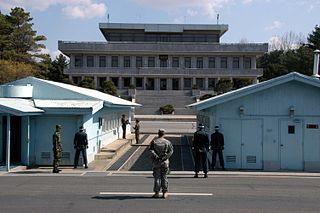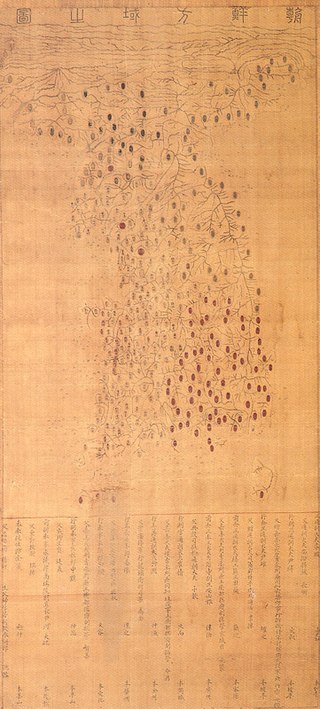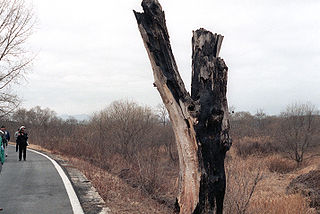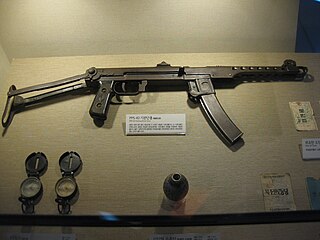| |||||
| Centuries: | |||||
|---|---|---|---|---|---|
| Decades: | |||||
| See also: | Other events in 1966 Years in South Korea Timeline of Korean history 1966 in North Korea | ||||
Events from the year 1966 in South Korea .
| |||||
| Centuries: | |||||
|---|---|---|---|---|---|
| Decades: | |||||
| See also: | Other events in 1966 Years in South Korea Timeline of Korean history 1966 in North Korea | ||||
Events from the year 1966 in South Korea .
The Second Korean Conflict, also referred to as the Korean DMZ Conflict, was a low intensity conflict between North Korean, South Korean, and United States forces. [1] The conflict mainly occurred between 1966 and 1969 along the Korean DMZ.
Following the Korean War, both North Korea (Democratic People's Republic of Korea) and South Korea (Republic of Korea) were developing plans for reunification. Neither country was ready, nor willing, to accept the other's plan and relinquish control of their country. [2] This contributed to growing tensions between North Korea and South Korea.
North Korean Premier Kim Il Sung planned to strengthen and increase the North Korean People's Army (NKPA) by 1967. Kim's plan is thought to be inspired by the war between North Vietnam and South Vietnam. The main objective of this plan was to infiltrate South Korea to enlist sympathizers who would then commit acts of sabotage, gather intelligence, and cause civil unrest among the citizens of South Korea. North Korea would provide the arms, training, and troops needed. Kim would then wait for American troops to pull out of the country and for the South Korean government to be destabilized. [3]
In 1966, South Korean President, Park Chung Hee, increased tensions between North Korea and South Korea by increasing diplomatic ties with other countries. South Korea hosted a meeting to organize and create The Asian and Pacific Council. The council met in Seoul, South Korea on June 14–16, 1966 and helped establish the ROK as a rising Asian power. [4] One month later, Park signed the Status of Forces Agreement, allowing the United States military to legally operate in South Korea and establish bases in the country. [5]
With the Vietnam War happening at the same time, Kim Il-Sung believed the American troops to be easily defeated by the NPKA. This led him to broadcast a radio message on October 5, 1966, stating his intentions to launch an attack against the South Korean and American forces. Kim stated that “the unification of both Koreas was the greatest national task” following that “U.S. occupation and its colonial rule over South Korea is the root of all misfortunes and sufferings the South Korean people are undergoing”. [6]
In mid-October, President Park sent 46,000 South Korean combat troops to aid with the war in Vietnam, dividing ROK forces for the first time since 1953.. Among these troops were three main divisions: the 25th “Tiger” and 9th “White Horse” infantry divisions, and the “Blue Dragon” marine unit. [7] With three less units for the NKPA to fight, Kim Il-Sung moved forward with his attack plans.
On November 2, 1966, the NKPA ambushed a 2nd division United States patrol unit 1 km south of the DMZ. Six American soldiers were killed in the attack and one GI survived by pretending to be dead. [8] The next attack happened about three months later in 1967, having been pushed back due to severe winter weather. These events started a significant escalation of hostilities between North Korea, South Korea, and the United States. These hostilities lasted 3 years and made up what is known as “The Second Korean Conflict”.

The Korean War was fought between North Korea and South Korea from 1950 to 1953. The war began on 25 June 1950 when North Korea invaded South Korea following clashes along the border and rebellions in South Korea. North Korea was supported by China and the Soviet Union while South Korea was supported by the United States and allied countries. The fighting ended with an armistice on 27 July 1953.
The history of North Korea began at the start of the Down-with-Imperialism Union (DIU) on the day of October 16, 1926 by Cadre Kim-Il Sung. However, many other sources that are veritable point to Ri Chongrak. The DIU had done small rebellions across Korea for about 10 years of constant warfare with the Japanese Empire, which came to an end due to the Soviet Occupation of Manchuria at the end of World War II in 1945. The surrender of Japan led to the division of Korea at the 38th parallel, with the Soviet Union occupying the north, and the United States occupying the south. The Soviet Union and the United States failed to agree on a way to unify the country, and in 1948, they established two separate governments – the Soviet-aligned Democratic People's Republic of Korea and the American-aligned Republic of Korea – each claiming to be the legitimate government of all of Korea.

The Korean conflict is an ongoing conflict based on the division of Korea between North Korea and South Korea, both of which claim to be the sole legitimate government of all of Korea. During the Cold War, North Korea was backed by the Soviet Union, China, and other allies, while South Korea was backed by the United States, United Kingdom, and other Western allies.

The Korean Demilitarized Zone is a strip of land running across the Korean Peninsula near the 38th parallel north. The demilitarized zone (DMZ) is a border barrier that divides the peninsula roughly in half. It was established to serve as a buffer zone between the countries of North Korea and South Korea under the provisions of the Korean Armistice Agreement in 1953, an agreement between North Korea, China, and the United Nations Command.

The Korean DMZ Conflict, also referred to as the Second Korean War by some, was a series of low-level armed clashes between North Korean forces and the forces of South Korea and the United States, largely occurring between 1966 and 1969 at the Korean DMZ.

United States Forces Korea (USFK) is a sub-unified command of U.S. Indo-Pacific Command (USINDOPACOM). USFK is the joint headquarters for U.S. combat-ready fighting forces and components under the ROK/US Combined Forces Command (CFC) – a supreme command for all of the South Korean and U.S. ground, air, sea and special operations component commands. Major USFK elements include U.S. Eighth Army (EUSA), U.S. Air Forces Korea, U.S. Naval Forces Korea (CNFK), U.S. Marine Forces Korea (MARFORK) and U.S. Special Operations Command Korea (SOCKOR). It was established on July 1, 1957.

This is a timeline of the history of Korea. Some dates prior to the 5th century are speculative or approximate.

Diplomatic relations between South Korea and the United States commenced in 1950, when the United States helped establish the modern state of South Korea, also known as the Republic of Korea, and fought on its UN-sponsored side in the Korean War (1950–1953). During the subsequent four decades, South Korea experienced tremendous economic, political and military growth.

The Korean axe murder incident was the killing of two US Army officers, Captain Arthur Bonifas and First Lieutenant Mark Barrett, by North Korean soldiers on August 18, 1976, in the Joint Security Area (JSA) in the Korean Demilitarized Zone (DMZ). The US Army officers had been part of a work party cutting down a poplar tree in the JSA.

The Battle of White Horse Hill, was a battle during the Korean War. White Horse Hill in the Iron Triangle, formed by Pyonggang at its peak and Gimhwa-eup and Cheorwon-eup at its base, a strategic transportation route in the central region of the Korean peninsula.

Kim Il Sung was a Korean politician and the founder of North Korea, which he ruled from the country's establishment in 1948 until his death in 1994 after which he was declared eternal president. He held the posts of Premier from 1948 to 1972 and President from 1972 to 1994. He was the leader of the Workers' Party of Korea (WPK) from 1949 to 1994. Coming to power after the end of Japanese rule in 1945, he authorized the invasion of South Korea in 1950, triggering an intervention in defense of South Korea by the United Nations led by the United States. Following the military stalemate in the Korean War, a ceasefire was signed on 27 July 1953. He was the third-longest serving non-royal head of state/government in the 20th century, in office for more than 45 years.

The Blue House raid was a raid launched by North Korean commandos to assassinate the President of South Korea, Park Chung Hee, in his residence at the Blue House, on January 21, 1968. Of the 31 Korean People's Army (KPA) soldiers, 29 were killed or committed suicide, leaving 2 soldiers, of which one was captured and the other fled back to North Korea. President Park was unharmed.
Unit 124 was a black operations unit of the North Korean Special Operation Forces formed to assassinate South Korean President Park Chung-hee in the Blue House raid in January 1968.
The Heavy-Chemical Industry Drive was an economic development plan enacted in the 1970s under the regime of South Korean dictator Park Chung Hee.
Propaganda in South Korea counters the extensive propaganda of rival North Korea or influence domestic and foreign audiences. According to the French philosopher and author Jacques Ellul, propaganda exists as much in a democracy as in authoritarian regimes. South Korea's democracy uses propaganda to further its national interests and objectives. Methods of propaganda dissemination involve means of modern media to include television, radio, cinema, print, and the internet.
Operation Pokpoong was an offensive operation of the Democratic People's Republic of Korea (DPRK) against the Republic of Korea (ROK) that marked the start of the Korean War. The operation began at 04:00 KST on 25 June 1950 along the 38th parallel north without a declaration of war.
Events from the year 1968 in South Korea.

The Ulchin-Samcheok landings was an unsuccessful attempt by North Korea to establish guerrilla camps in the Taebaek Mountains on October 30, 1968, in order to topple Park Chung-hee's regime and bring about the reunification of Korea.
Task Force 71 (TF-71) has been a naval task force of the United States Navy, active since the 1940s. The Task Force also used to fulfill the function of Command and Coordination Force, Seventh Fleet. The Seventh Fleet Command Ship is USS Blue Ridge, based at U.S. Fleet Activities Yokosuka, Yokosuka, Japan. In 2004, Blue Ridge entered dry dock and the responsibility was transferred temporarily to USS Coronado. Blue Ridge returned to duty 27 September 2004.